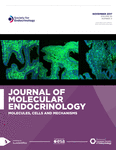60 YEARS OF POMC: Purification and biological characterisation of melanotrophins and corticotrophins
- Correspondence should be addressed to P Lowry; Email: p.j.lowry{at}reading.ac.uk
Abstract
The remarkable conservation of the primary structures and anatomical location of dogfish α-melanocyte-stimulating hormone (MSH), corticotrophin-like intermediate lobe peptide (CLIP) and adrenocorticotrophic hormone (ACTH) compared with mammals reinforced the tissue-specific processing hypothesis of ACTH peptides in the pituitary gland. The cloning of dogfish pro-opiomelanocortin (POMC) led to the identification of δ-MSH and simultaneously revealed the high conservation of the γ-MSH sequence during evolution. These studies have also shown that β-MSH is much less conserved during evolution and in some species is not even processed from β-LPH. Human pro-γ-MSH potentiates the corticosteroidogenic activity of ACTH and peptides generated from its N-terminal, in particular big-γ-MSH, appear to have adrenal mitogenic activity. Human big-γ-MSH (from the zona intermedia) may also cause the adrenache. The review finishes with a cautionary note with regard to the misdiagnosis of the ectopic ACTH syndrome in which partial processing of ACTH can result in large concentrations of α-MSH and CLIP, which can interfere in the performance of two-site immunoassays, and the problem of the correct disulphide bridge arrangement in synthetic N-POMC peptides is also discussed.
- Received 3 December 2015
- Accepted 7 December 2015
- Made available online as an Accepted Preprint 1 May 2016
- © 2016 Society for Endocrinology











